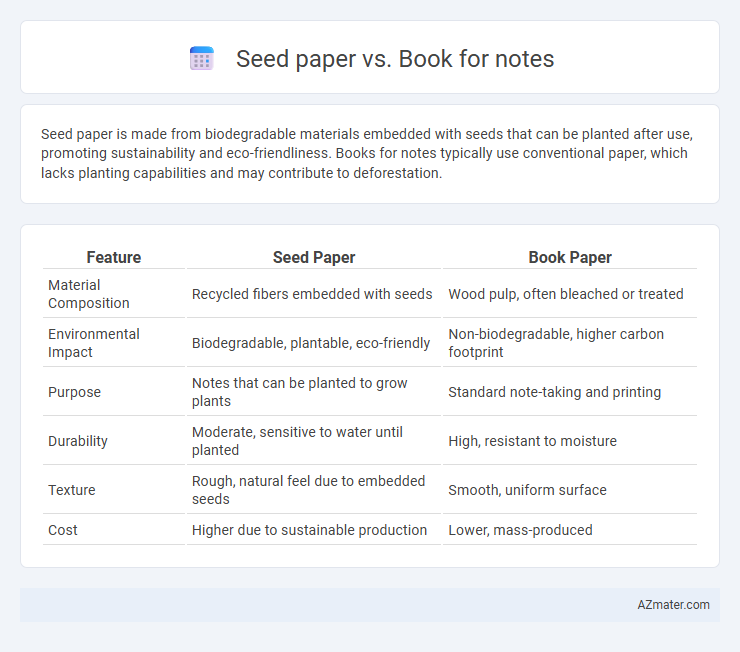Seed paper is made from biodegradable materials embedded with seeds that can be planted after use, promoting sustainability and eco-friendliness. Books for notes typically use conventional paper, which lacks planting capabilities and may contribute to deforestation.
Table of Comparison
| Feature | Seed Paper | Book Paper |
|---|---|---|
| Material Composition | Recycled fibers embedded with seeds | Wood pulp, often bleached or treated |
| Environmental Impact | Biodegradable, plantable, eco-friendly | Non-biodegradable, higher carbon footprint |
| Purpose | Notes that can be planted to grow plants | Standard note-taking and printing |
| Durability | Moderate, sensitive to water until planted | High, resistant to moisture |
| Texture | Rough, natural feel due to embedded seeds | Smooth, uniform surface |
| Cost | Higher due to sustainable production | Lower, mass-produced |
Introduction to Seed Paper and Traditional Books
Seed paper is an eco-friendly, biodegradable material embedded with plant seeds that can be planted after use, promoting sustainability and reducing waste. Traditional books are composed of conventional paper derived from wood pulp, offering durability and long-lasting readability but contributing to deforestation and landfill accumulation. While seed paper notebooks emphasize environmental impact and regeneration, conventional books focus on preservation and conventional print quality.
Environmental Impact: Seed Paper vs Book
Seed paper significantly reduces environmental impact by utilizing recycled materials embedded with seeds that can be planted after use, promoting sustainability and reducing waste. Traditional books often involve deforestation, energy-intensive manufacturing, and chemical use, contributing to carbon emissions and habitat loss. Choosing seed paper notes supports eco-friendly practices by minimizing resource consumption and encouraging circular lifecycle benefits compared to conventional paper books.
Material Composition and Sustainability
Seed paper is made from recycled fibers embedded with seeds, allowing it to decompose and grow plants when planted, making it a highly sustainable choice. Book paper typically consists of wood pulp treated with chemicals and lacks biodegradability, leading to environmental concerns over deforestation and waste. Seed paper's eco-friendly material composition promotes circular life cycles, whereas traditional book paper prioritizes durability but often at the expense of sustainability.
Writing Experience: Feel and Usability
Seed paper offers a textured, eco-friendly writing surface that absorbs ink uniquely, giving notes an organic feel, while traditional books provide a smooth, consistent page ideal for various pen types and prolonged writing sessions. Seed paper's usability is often limited due to its fragility and seed-embedded composition, making it less durable but perfect for short-term notes or special projects. Books, designed for longevity, support extensive note-taking and easy page turning, enhancing usability for study and reference purposes.
Lifespan and Durability Comparison
Seed paper offers an eco-friendly option with limited lifespan due to its biodegradable and plant-embedded nature, often lasting only a few months before breaking down. Books for note-taking, typically made from durable, acid-free paper, provide long-term preservation lasting years or even decades under proper care. The choice between seed paper and traditional notebooks hinges on whether users prioritize sustainability and eventual decomposition or enduring durability for archival purposes.
Recyclability and Biodegradability
Seed paper is highly recyclable and biodegradable, designed to break down naturally in soil while promoting plant growth, making it an eco-friendly alternative to traditional paper. Books, typically made from standard paper, are recyclable but their biodegradability varies depending on inks, coatings, and bindings used, often slowing decomposition. Choosing seed paper for notes enhances sustainability through seamless recyclability and natural biodegradability, reducing environmental impact compared to conventional book paper.
Creative Applications and Customization
Seed paper offers innovative creative applications by embedding plant seeds within the material, allowing notes to be planted and transformed into growing plants, which adds an eco-friendly, interactive element for personalized gifts, event invitations, or artistic projects. In contrast, traditional books provide extensive customization through various bindings, cover designs, paper quality, and print formats, enabling tailored aesthetic and functional options for note-taking or journaling. Combining seed paper elements with customizable book formats can enhance sustainability while maintaining versatile customization for creative note applications.
Cost Considerations and Accessibility
Seed paper generally incurs higher initial costs due to its eco-friendly materials and limited production scale, while traditional books for note-taking are often more affordable and widely available. Accessibility favors books since they can be purchased in various formats, including digital versions that provide instant access and portability. Cost savings in books come from mass production and established supply chains, whereas seed paper's value lies in sustainability rather than price efficiency.
Ideal Use Cases for Seed Paper and Books
Seed paper is ideal for eco-conscious users who want to combine note-taking with sustainability, perfect for jotting down ideas that can later be planted to grow flowers or herbs, making it suitable for gardening enthusiasts and environmental advocates. Books excel as durable, comprehensive repositories for detailed notes, study materials, and extensive writing, ideal for students, researchers, and professionals requiring long-term reference. The choice depends on whether the priority is environmental impact and creativity with seed paper or durability and volume with traditional books.
Choosing the Best Option for Your Notes
Seed paper offers eco-friendly benefits with its biodegradable material embedded with seeds that can be planted after use, making it ideal for sustainable note-taking. Books for notes provide durability, ample writing space, and the convenience of organized record-keeping, which suits long-term note management and frequent referencing. When choosing the best option, consider your environmental values, note-taking habits, and the intended use--seed paper caters to short-term, eco-conscious notes, while notebooks excel in structured, lasting documentation.

Infographic: Seed paper vs Book for Note
 azmater.com
azmater.com